In this tutorial, we will be looking at how to perform a forehand pendulum backspin/sidespin serve in table tennis. As a more advanced serve, the idea is to prevent the receiver from making a strong attack against the serve, and hopefully force a weak return instead that can be third ball attacked.
Ready Position
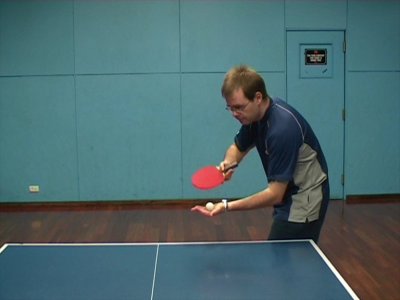
Points to look for:
- The serve is called a pendulum serve because the movement of the bat resembles the way the weight on a pendulum (such a grandfather clock) moves back and forth.
- This serve is typically performed from the server’s backhand corner. This is because the type of sidespin put on the ball will tend to make the receiver’s return go towards the server’s backhand. Most servers are looking to take a step to their left and hit a powerful forehand attack from their backhand corner. The use of sidespin helps the server to control the likely placement of the return.
- The free hand is flat, stationary, and above the playing surface and behind the endline.
- The bottom three fingers of the racket hand have been loosened, to allow the bat to be moved more freely when serving. This makes it easier to put more varieties of spin on the ball.
- The amount of sidespin and backspin will be varied constantly, in order to make it more difficult for the receiver to judge the correct amount of spin on the ball.
- The use of sidespin makes it harder for the receiver to tell how much backspin is on the ball, since the ball has a combination of backspin and sidespin.
Start Of Ball Toss
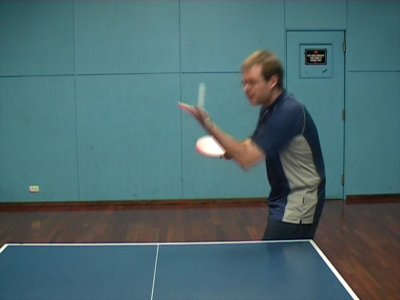
© Greg Letts
The service motion has begun, and the ball has been thrown into the air.
Points to look for:
- The player is watching the ball as he makes the toss.
- The bat is being taken upwards and backwards in preparation for the forward swing.
- The ball is being thrown near vertically upwards from an open palm, as per the laws of serving in ping-pong.
- The player has straightened up a little from his crouch as part of the service motion.
Top Of Ball Toss
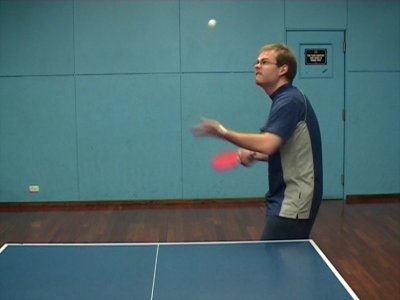
© Greg Letts
The ball is at the top of its ascent.
Points to look for:
- The player is continuing to watch the ball closely.
- The free arm is on its way down, and will shortly be moved to the side to conform with the rules of table tennis which state that the free arm must be moved from the space between the ball and the net as soon as the ball is projected.
- This is a fairly high ball toss, which suits the player’s own rhythm. A higher ball toss will give a little more speed and spin on the ball, but a lower ball toss is perfectly acceptable. In fact, varying the height of the ball toss is a good idea.
End Of Backswing
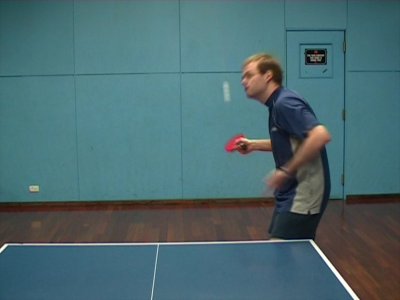
© Greg Letts
The ball is descending, the player has finished his backswing, and is about to swing forward to contact the ball for service.
Points to look for:
- The thumb can be seen to have moved up the blade onto the rubber, since the bat is being held between the thumb and the index finger, with the other three fingers being fairly loose on the handle.
- The bat face is held at an angle, since the player wishes to put backspin and sidespin on the ball.
- The player has not kept track of the ball once it starts to descend. This is because this serve has been practiced often by the player, and once he knows where the ball is descending from, he does not need to see the ball to be able to make good contact.
- The free arm has continued to move out of the area between the ball and the net, so that the receiver will have a clear view of the ball throughout the service motion, as required by the rules.
Pre-Contact With The Ball
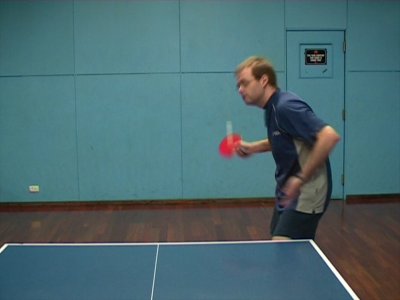
© Greg Letts
The player is just about to make contact with the ball.
Points to look for:
- As mentioned previously, the player will not be watching the contact of the ball, since this serve is a familiar routine.
- The shoulders are just beginning to turn to the left of the player, which will add to the spin, and help the player recover to a neutral position faster.
- The bat has started to move, but the player has not yet snapped his wrist forward. This shows how the wrist snaps at the last possible moment.
- The height of the contact shown in the photograph is a little misleading, due to the angle of the camera. The ball appears to be a little higher in relation to the table than it really is.
- Note how the receiver has an unobstructed view of the contact with the ball.
Contact With The Ball
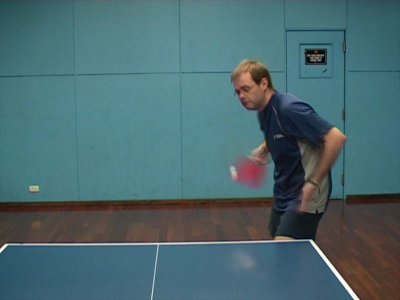
© Greg Letts
The ball has now been struck by the player.
Points to look for:
- The wrist has now snapped forward, as can been seen by the change in where the tip of the bat is now pointing. This is why the serve is called a pendulum serve.
- The bat has made contact slightly underneath and to the right side of the ball, as viewed by the camera. The underneath motion will put backspin on the ball, while the left to right motion will put sidespin on the ball. This combination of spins is harder for an opponent to read than just pure backspin or pure sidespin.
- Since the receiver can clearly see the contact of the ball, deception is achieved by varying the angle at which the bat is held, which will change the proportion of sidespin to backspin. Further deceptions can be made by changing the amount of wrist snap used, or the speed with which the playing arm is moved. The amount of brush can also be varied to add to the deception of the serve.
- The ball has been brushed heavily to give good spin, with only a little bit of solid contact. This is designed to give a slow, spinny serve, that will bounce twice on the opponent’s side of the table if left untouched.
End Of Follow Through
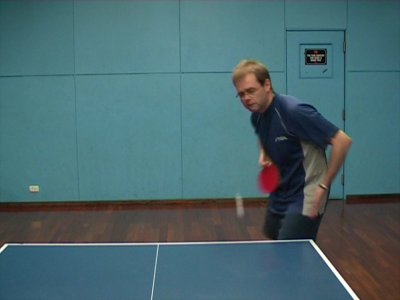
© Greg Letts
The ball has been struck and is on its way towards the table, while the player has finished his follow through.
Points to look for:
- The player has begun to watch the ball again, since he is looking to see the result of the serve. If he sees that the serve will successfully go low over the net and bounce twice on the opponents side of the table, he will look for an aggressive third ball. If he sees that he has not served a good serve (too high or too long), he will get ready for an attack by the receiver.
- The follow through has ended quite soon after hitting the ball, since the player wishes to make a quick recovery to a ready position.
- The shoulders, hips and waist have all turned a little more to the player’s left, which will reduce the amount of movement necessary to get into a neutral ready position.
- As shown by the small blur trail, the ball is not moving forward all that fast, since much of the speed of the bat has been converted into spin.
- Note also that although the player’s stroke was a mixture of forward and left to right movement (as viewed by the camera), the ball is moving straight forward. This is because the spin put on the ball tends to throw it in the direction that the bat is moving (forward and to the right), while the angle of the bat face (which was facing to the bottom left of the photograph) tends to push the ball to the left. The left and right forces have almost cancelled out in this particular serve, producing a serve that is moving forward.
Start Of Return To Ready Position
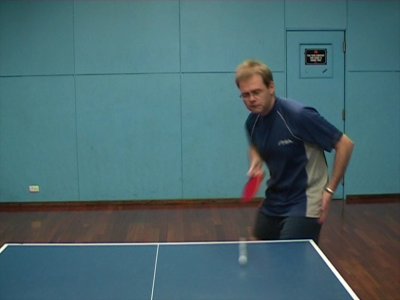
© Greg Letts
The ball is about to bounce on the table, and the player is starting to return to his ready position.
Points to look for:
- The bat is now being moved to the player’s right to return to its ready position, while the hips, waist and shoulders continue to turn to the left.
- The player’s right leg can now be seen to be moving to his right, as he starts to get squarer to the endline of the table.
- The player is watching the bounce of the ball closely.
- The ball is moving almost straight forward.
Middle Of Return To Ready Position
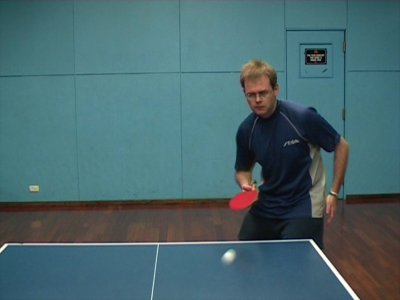
© Greg Letts
The ball has now bounced on the table, and the player is continuing his recovery.
Points to look for:
- The player is continuing to move his bat forward and to the right, to bring it into its ready position.
- The hips, waist and shoulders have turned further to the player’s left.
- The right leg has continued to move to the player’s right.
- By comparing the previous two photographs with this one, the ball can be seen to have turned to the left of the camera upon bouncing, due to the spin on the ball.
- The player is continuing to watch the ball closely, in order to gauge the success of the serve.
Return To Ready Position

© Greg Letts
The player has almost finished returning to his ready position.
Points to look for:
- The hips, waist and shoulders are now in position.
- The player has moved his weight from his left leg onto both legs.
- The right leg is slightly behind the left leg, in standard ready position. The legs should be a little further apart for optimum balance and ease of movement.
- The player simply needs to tilt his bat so that the edge is vertical to bring his racket into ready position.
- The free arm only has to lift forward from the elbow to be in position.
- The player is now watching how the opponent is handling his serve.
- Note that the player is standing well towards the backhand side of the table – this is because the sidespin put on the ball will make it difficult for the opponent to put the ball wide to the player’s right, since the ball will tend to bounce off the opponent’s racket towards the player’s left. So the player is actually standing in a fairly central position to cover the possible angles available to his opponent.

